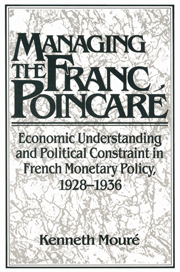 Managing the Franc Poincaré
Managing the Franc Poincaré Published online by Cambridge University Press: 23 November 2009
French economic performance in the interwar years was sharply divided by the onset of the depression in 1930. The 1920s were a period of strong growth as France rebuilt war-damaged areas, depreciation of the franc encouraged exports, and a “neocapitalist” economic reform movement pressed for the modernization of French industry. The arrival of the depression in 1930 has been described as an “economic Sedan” halting the modernization of the French economy. Late to arrive in France, the slump persisted through the decade, weakening and demoralizing the country as it faced the threat and then the reality of another war.
Two facets of the depression in France are treated in this chapter. The first is the extent to which monetary factors account for France's resistance to the economic crisis in 1929 and 1930 and for the persistence of the depression through the rest of the 1930s. The franc Poincaré, undervalued by its de facto stabilization in 1926 and overvalued after the fall of the pound sterling in 1931, has played the principal role in most accounts. There are difficulties with this interpretation that suggest the need for greater attention to domestic factors, particularly fiscal policy, in order to explain the peculiarities of the slump in France. The first section of this chapter reviews French economic performance between the wars and the debate on the importance of the franc Poincaré to French experience of the depression.
The second section examines the French reaction to the onset of the crisis, with particular attention to its monetary aspects. Perceptions of why the depression occurred and how it came to France influenced the means by which policy makers sought to restore prosperity.
To save this book to your Kindle, first ensure no-reply@cambridge.org is added to your Approved Personal Document E-mail List under your Personal Document Settings on the Manage Your Content and Devices page of your Amazon account. Then enter the ‘name’ part of your Kindle email address below. Find out more about saving to your Kindle.
Note you can select to save to either the @free.kindle.com or @kindle.com variations. ‘@free.kindle.com’ emails are free but can only be saved to your device when it is connected to wi-fi. ‘@kindle.com’ emails can be delivered even when you are not connected to wi-fi, but note that service fees apply.
Find out more about the Kindle Personal Document Service.
To save content items to your account, please confirm that you agree to abide by our usage policies. If this is the first time you use this feature, you will be asked to authorise Cambridge Core to connect with your account. Find out more about saving content to Dropbox.
To save content items to your account, please confirm that you agree to abide by our usage policies. If this is the first time you use this feature, you will be asked to authorise Cambridge Core to connect with your account. Find out more about saving content to Google Drive.